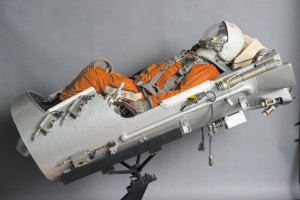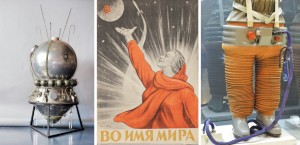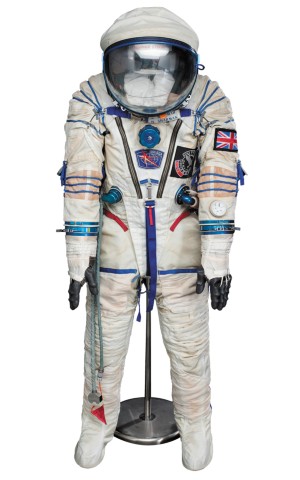Tim Radford is thrilled by an unprecedented exhibition marking the USSR's cold war feats in space.
Cosmonauts: Birth of the Space Age
Science Museum, London. Until 16 March 2016..
Between the cold war years of 1957 and 1966, the Soviet Union established primacy in space. Its heady list of triumphs embraces, in the 1950s alone, the first artificial object and first animal in orbit, and the first image of the far side of the Moon. In the next decade, it grew to include the first attempt on Venus, the first man in space, the first woman in space, the first three-man mission in space, and the first spacewalk, automaton touchdown on the Moon, lunar rover (1970), and scoop of Moon rock brought back to Earth by an automaton. Reflecting the significance and extent of those triumphs, the long-awaited Cosmonauts at the Science Museum in London assembles memorabilia and engineering marvels borrowed from around a score of Russian institutes.

It opens with dreams: of high orbit, free fall and exit through an airlock, sketched on paper in 1933 by schoolmaster and rocket visionary Konstantin Tsiolkovsky. It concludes with a recumbent mannequin in a cradle (a “tissue equivalent phantom” flown in 1969 to absorb and measure space radiation), representing the Soviet dream of a crewed mission to Mars, and a quotation attributed to Tsiolkovsky: “Earth is the cradle of humanity, but one cannot live in a cradle forever.” In between is a parade of hardware that none of us who followed the news greedily in those years had ever dreamed we might see assembled in one place, let alone in South Kensington.
The models are marvels. Here is a highly polished display model of Sputnik 1, launched in October 1957 (its chief designer, Sergei Korolev, reportedly said, “This ball will be exhibited in museums”). There are two engineering models: one of the two Lunokhod lunar rovers, the other of the once-secret lander Lunniy Korabi, designed to deliver one cosmonaut to the lunar surface in 1969. It flew, but not to the Moon, and the rest of us knew of its existence only two decades later.
And then there are the real things. Along with the charred, three-person Voskhod 1 descent module used in 1964 is the descent module of Vostok 6. In it, cosmonaut Valentina Tereshkova orbited Earth for three days in 1963 before a return during which the heat shield was scorched by impact with Earth's atmosphere at 27,000 kilometres an hour. This is iconic stuff: the RD-108 engine that powered the space race; the complex space toilet designed to drain human waste aboard the space station Mir; the powered backpack with port and starboard lights for free flight beyond the spacecraft.

But what sets the scalp prickling are the little things that tell those other stories implicit in this dizzying show. There is Georgy Krutikov's 1928 drawing Labour Commune, a stratospheric dream prefiguring the great adventure. And there is a little metal mug once owned by Korolev, the man most people now recognize as the driver of the space race, and thus the hero of this story.
Korolev, a Ukrainian, had been incarcerated in a prison camp in the Kolyma region of Siberia during Joseph Stalin's notorious 1930s purges. No Westerner — and few Russians — knew his name during the cold war, so closed was the Soviet world. Fresh from wartime labour detention, he arrived at the German Peenemünde base of the Nazi V-2 rocket programme to realize the dream of planetary exploration.
Sputnik 1 jolted Western complacency and helped to reignite the US space programme originally launched by the aerospace engineer and Nazi-turned-émigré Wernher von Braun. When Korolev died in 1966 during what should have been a routine operation, the new Soviet leader Leonid Brezhnev was a pallbearer. Even then, no one in the West knew of Korolev's existence.

Inevitably, the rocket engineer's genius surfaces again and again through the exhibition. There is a letter signed by Stalin authorizing the intercontinental ballistic-missile programme that made Sputnik 1 possible, and the personalized number plate YG1, used by Yuri Gagarin, the foundry worker who became a fighter pilot and, in 1961, the first man in space. There is Korolev's freehand drawing of the launch of canine cosmonauts Strelka and Belka. Alongside triumphant official Socialist realist posters there is a white lab coat daubed in red with the Russian for “Space is ours”, a memento of a spontaneous 1961 celebration in Red Square. The pencils and sketch pad that Alexei Leonov took on his pioneering 1965 spacewalk — a near-catastrophe — are here, along with a later self-portrait of him floating at the end of a tether over the Black Sea.
The United States' role in the space race is hardly acknowledged, beyond a Time magazine cover declaring Soviet premier Nikita Khrushchev its 1957 man of the year. But the Soviet space effort seemed to lose momentum as the US Apollo programme — a story told in the Science Museum's main galleries — began in every sense to take off. Korolev's death must also have been a factor. The wonders went on, but the never-admitted race for the Moon was all but over.
This cosmic cornucopia reflects the intoxication of those first years and looks forward to the age of the space station. There is a spoon used aboard Mir by Sergei Krikalev, the man who went up as a Soviet cosmonaut and came down in 1992 as a citizen of the Russian Federation (and yes, there is a Soyuz descent module that carried a Mir crew back to Earth that year). But this unprecedented collection delivers more than a glimpse of distant exploratory technologies. It is a snapshot of Soviet history and, because the cold war warped the twentieth century, of global history, too. And where else could you see an ejector seat for a dog? The exhibits impose their own metaphors: see this show and be uplifted, transported, taken out of this world. It is the curatorial equivalent of a legal high.
Author information
Authors and Affiliations
Corresponding author
Related links
Related links
Related links in Nature Research
Nature collection: Russian science
Nature special: 30 years of the space shuttle
Related external links
Rights and permissions
About this article
Cite this article
Radford, T. Space travel: When Soviets ruled the great beyond. Nature 525, 452–453 (2015). https://doi.org/10.1038/525452a
Published:
Issue Date:
DOI: https://doi.org/10.1038/525452a
